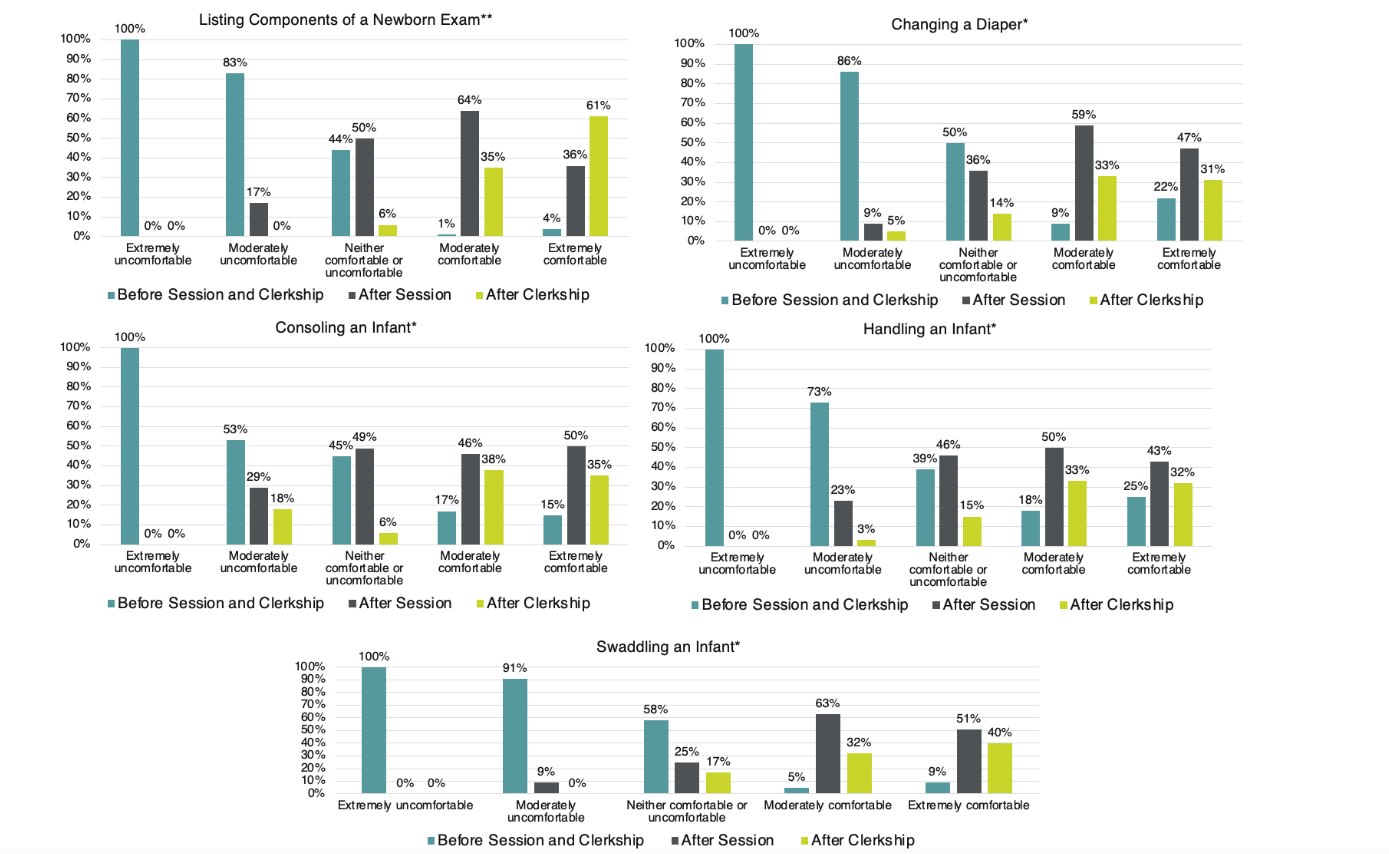Medical Education 2: Curricular innovations and assessment 2
Session: Medical Education 2: Curricular innovations and assessment 2
505 - Integration of a Newborn Exam Clinical Skills Session in the Pediatric Clerkship
Friday, April 25, 2025
5:30pm - 7:45pm HST
Publication Number: 505.5177
Brandon J. Wong, Stony Brook Children's Hospital, Santa Ana, CA, United States; Christina M. Mazza, Stony Brook Children's Hospital, Holtsville, NY, United States; Sarah Corin, Stony Brook Children's Hospital, Denver, CO, United States; Maribeth Chitkara, Stony Brook Children's Hospital, Stony Brook, NY, United States

Brandon Wong, MD (he/him/his)
Resident
UCI-CHOC
Santa Ana, California, United States
Presenting Author(s)
Background: The importance of the performance of the physical examination of the patient is emphasized in the AAMC’s first core entrustable professional activity (EPA1: Gather a History and Perform a Physical Examination).[1] A 2017 survey of medical students reported that nearly 40% felt inadequately prepared to perform a pediatric physical exam before starting their pediatrics clerkship.[2] At the Renaissance School of Medicine, students customarily receive their first infant physical exam training during a week in the newborn nursery.
Objective: To develop and implement a one-hour skill session dedicated to infant physical examination and handling prior to any clinical clerkship activities so as to equip students with both the tools and proper techniques to care for newborn patients during their pediatric rotation.
Design/Methods: The newborn skills teaching session was divided into demonstrations followed by student practice. Stations included infant physical exam skills, diaper changing, general infant handling, swaddling and consoling. Students were surveyed prior to the session (T0), following the session (T1), and at the end of the pediatric clerkship (T2) with a 5-point Likert scale questionnaire rating their comfort level with session tasks. An open-ended feedback response was included in T1 and T2. Descriptive and Mann-Whitney statistical analysis was performed using IBM SPSS on quantitative data. Thematic analysis was performed by three independent researchers on qualitative data.
Results: 82 participants were included in this study. 13.4% had prior experience with newborns. Response rates for T0 and T1 were 100%, while T2 was 57.3% (Figure 1). There was a significant difference between T0-T1 and T0-T2 in student comfort levels across all of the tasks (p < 0.001). There was a significant difference between T1 and T2 for “Listing components of a newborn exam” (p < 0.001) (Figure 2). Analysis of open ended responses emphasized student overall satisfaction as well as suggestions for improvements for future sessions.
Conclusion(s): A teaching intervention was created to introduce newborn care to pediatric clerkship students at RSOM. Significant improvement was noted in comfort across tasks post-session. Limitations of the study include the applicability of skills attained via practice with an infant manikin to a clinical setting with live newborns. Future direction for this study will include analysis of skills attained from the teaching session to those practiced with newborn infants during their nursery rotation.
1. Lomis, et al. Academic Medicine. 2017.
2. Held, et al. Medical Science Educator. 2017.
Figure 1
.png) Demographics showing the number of trainees responding (1A), the number of trainees with prior newborn experience (1B).
Demographics showing the number of trainees responding (1A), the number of trainees with prior newborn experience (1B).Figure 2
 Comfort level of newborn tasks throughout the clerkship grouped into T0 (before clerkship), T1 (after session), and T2 (after clerkship). (*p < 0.001 for T0-T1 and T0-T2, **p < 0.001 for T0-T1, T0-T2, and T1-T2)
Comfort level of newborn tasks throughout the clerkship grouped into T0 (before clerkship), T1 (after session), and T2 (after clerkship). (*p < 0.001 for T0-T1 and T0-T2, **p < 0.001 for T0-T1, T0-T2, and T1-T2)Figure 1
.png) Demographics showing the number of trainees responding (1A), the number of trainees with prior newborn experience (1B).
Demographics showing the number of trainees responding (1A), the number of trainees with prior newborn experience (1B).Figure 2
 Comfort level of newborn tasks throughout the clerkship grouped into T0 (before clerkship), T1 (after session), and T2 (after clerkship). (*p < 0.001 for T0-T1 and T0-T2, **p < 0.001 for T0-T1, T0-T2, and T1-T2)
Comfort level of newborn tasks throughout the clerkship grouped into T0 (before clerkship), T1 (after session), and T2 (after clerkship). (*p < 0.001 for T0-T1 and T0-T2, **p < 0.001 for T0-T1, T0-T2, and T1-T2)
